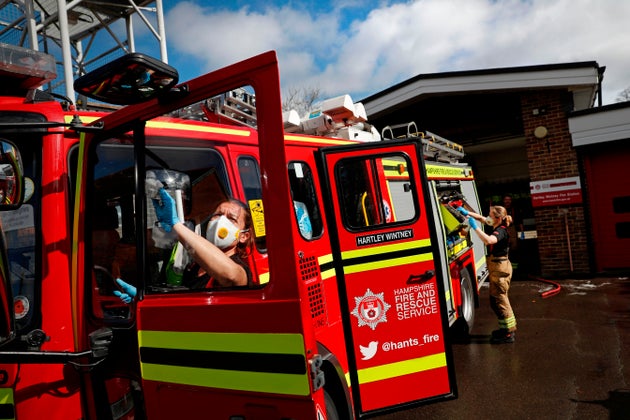More than three quarters of the UK’s fire services struggled to access personal protective equipment (PPE) at the start of the Covid-19 crisis, and had no guidance on how to manage the shortage.
In a new report seen exclusively by HuffPost UK, the Fire Brigades Union (FBU) said that firefighters on the frontlines – delivering PPE, food and medicine, and transporting bodies to mortuaries – faced severe shortages of safety and hygiene supplies at the height of the pandemic.
With the UK now firmly into a second wave of the virus, the FBU is calling for increased testing for staff. The government announced in April firefighters could be tested – but only those showing symptoms. The FBU, which estimates testing rates of below 5% of workers, wants weekly testing for all firefighters.
The report states that despite lessons learnt during the swine flu epidemic and the global release of additional health advice, the government’s guidance for fire services in the case of a pandemic has not been updated since 2008.
“Pandemic Flu: Guidance for the Fire and Rescue Service”, created by what was then the Department of Health and the Health Protection Agency more than a decade ago, does not even address what firefighters should do in the case of a shortage of PPE during a pandemic.
By late March, the FBU said, more than three quarters of fire and rescue services reported PPE supply chain issues – with masks, hand sanitiser, wipes, cloths and coveralls all in short supply.
The lack of equipment and supplies extended into April, with members of the union across the country reporting problems with accessing essential cleaning products for specialist breathing equipment, as well as other basic PPE.
Some services also reported that European lockdowns meant staff could not access spare parts and tools to maintain firefighting equipment, while other teams said they had difficulties with computer systems and hardware during the peak of the crisis.
FBU general secretary Matt Wrack said: “As death tolls soared earlier in the year, firefighters stepped in to aid their communities in their darkest hour. With a second wave of infections now arriving, our crews are staying on high alert.
“Much like their colleagues in the NHS, firefighters and control staff have had to pick up the pieces for a government that gutted their service with austerity and failed to prepare for the entirely foreseeable risk of a pandemic.”

Thousands of fire service staff were also forced to self-isolate during the first wave, with FBU figures revealing almost 3,000 employees were in self-isolation in early April – though services were still able to largely function as normal.
The union’s report reveals employee absence due to coronavirus peaked at just over 4,000 (8% of the workforce) at the end of March – but control room absences at some services hit 20% at points during the crisis.
The FBU report comes as it agrees to continue its work at the front lines of the virus as a second peak approaches.
New data, published by the union, reveals fire services have intervened more than 400,000 times during the pandemic, with two thirds of crews involved with transporting victims’ bodies to mortuaries.
Some 80% of fire services also helped distribute more than 80,000 food packages, medicines and other essentials to vulnerable people, while 75% of services helped drive ambulances and assisted the ambulance service.
Even as they struggled to access their own PPE, 70% of fire services were brought in to deliver protective equipment to other frontline workers, with the majority going to the NHS.
A DHSC spokesperson said: “The government has had significant engagement with the National Fire Chiefs Council throughout the pandemic, and the fire and rescue service have confirmed they have always had adequate PPE supplies.
“We are working around the clock to ensure PPE is reaching the frontline, and since the start of the outbreak, we’ve delivered 3.7bn pieces of PPE and have now secured an uninterrupted supply to meet the challenges in the coming months.
“There is a high demand for tests, but we are working to increasing capacity to 500,000 tests a day by the end of October. We are targeting capacity at the areas that need it most, including outbreaks, those in at-risks groups and the message to the public is clear – get a test if you have symptoms.”